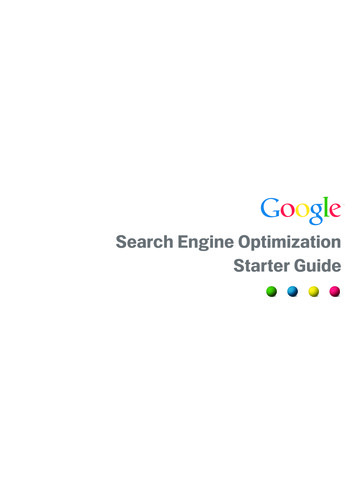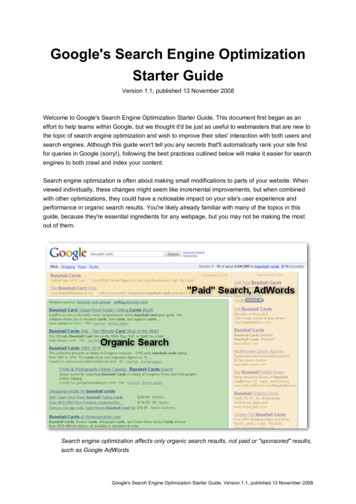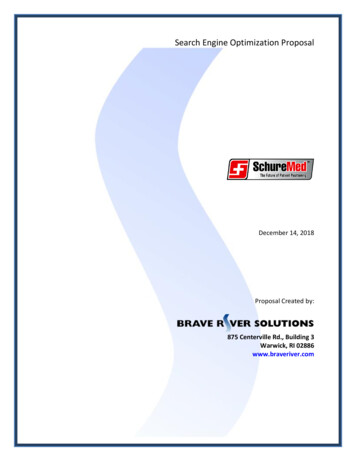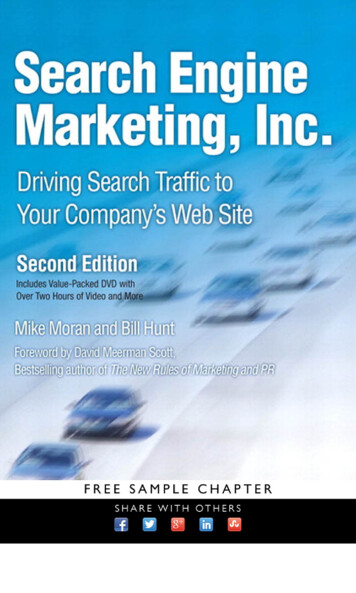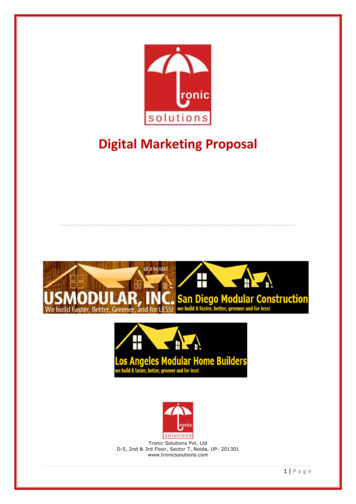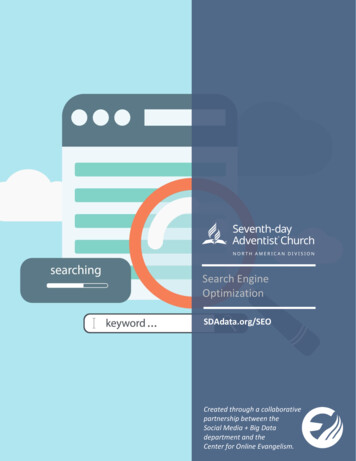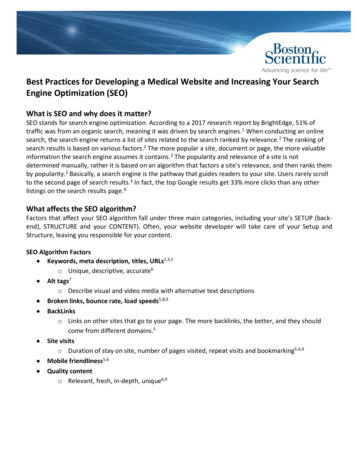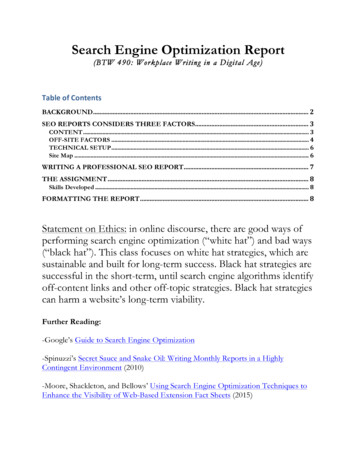
Transcription
Search Engine Optimization Report(BTW 490: Workplace Writing in a Digital Age)TableofContentsBACKGROUND.2SEO REPORTS CONSIDERS THREE FACTORS.3CONTENT.3OFF-SITE FACTORS.4TECHNICAL SETUP.6Site Map.6WRITING A PROFESSIONAL SEO REPORT.7THE ASSIGNMENT.8Skills Developed.8FORMATTING THE REPORT.8Statement on Ethics: in online discourse, there are good ways ofperforming search engine optimization (“white hat”) and bad ways(“black hat”). This class focuses on white hat strategies, which aresustainable and built for long-term success. Black hat strategies aresuccessful in the short-term, until search engine algorithms identifyoff-content links and other off-topic strategies. Black hat strategiescan harm a website’s long-term viability.Further Reading:-Google’s Guide to Search Engine Optimization-Spinuzzi’s Secret Sauce and Snake Oil: Writing Monthly Reports in a HighlyContingent Environment (2010)-Moore, Shackleton, and Bellows’ Using Search Engine Optimization Techniques toEnhance the Visibility of Web-Based Extension Fact Sheets (2015)
Search Engine Optimization ReportBACKGROUNDFor our next assignment, we will write an SEO report. SEO is an acronym for SearchEngine Optimization. The term describes the process used to boost a website’s ratingwhen it is searched for on an Internet search engine—i.e., Google, Yahoo, Bing,etc.—and the page rank that website has in relation to other similar websites. SEOwriters use web content and tags (HTML code) in the structure of the webpage toimprove the online performance of a website.SEO is the process of improving the visibility of a website or a web page in a searchengine’s unpaid results (i.e., natural, organic, or earned). SEO can be used for a varietyof online content, including searches for image and video, academic, and industry.SEO has a long complicated history and can be used both ethically and spuriously.SEO is relevant in the world of e-commerce and online business, and for thoseinvolved in the creation of web sites and web content. Because most Internet usersdon’t browse past the first page of search results they are offered, the higher a websitecan rank for a given keyword or phrase, the better its chances are of bringing in newcustomers.For our SEO project, we will focus on the improvements made to a website2
Search Engine Optimization ReportSEO REPORTS CONSIDERS THREE FACTORSTechnicalSetupContentOff- ‐sitefactorsCONTENTWhat is a Page Rank?Page rank is a way of determining a website’s importance dependent on its desirabilityand exposure. The term was derived by Google, who developed an algorithm tocalculate rankings. When this algorithm is executed, it determines the number of linkspointing to a website, the amount of relevant content it contains, and then assigns it anumber between 1 and 10; 1 being the lowest level of rank, 10 being the highest. Thehigher a page rank, the better chance a website has of appearing at the top of anInternet search result page.What is a Keyword?A keyword is a word or phrase an Internet user will enter into a search engine whentrying to locate something, i.e., a product or information. For example, a websiteselling herbal tea will list keywords such as, “herbal,” “tea,” and “tea bags,” etc.3
Search Engine Optimization ReportWhat is Keyword Density?Keyword density is the numerical factor derived from dividing the number of wordson the page of a website, by the number of keywords that are used within it. Themore keywords used throughout a web page (and ultimately the entire site), the betterthe website will rank for that keyword or phrase. Websites that have too high adensity tend be considered as spam by search engines, and may be excluded.OFF-SITE FACTORSPay-Per-Click advertising (covers creating compelling search advertising in Googleand Bing [which also includes Yahoo!], display network advertising, affiliateadvertising, and much more)Social Media Marketing (covers creating fresh, compelling content and drawingfollowers [and the ultimate goal, sales] via many online venues, such as Facebook,Twitter, Google , LinkedIn, YouTube, Flickr, FourSquare, Pinterest, and manymore)Local search (covers getting business profiles created in the major search engines,mapping sites, major search directories for business, niche industry directory sites,local media sites, and more)On-page (covers an examination of all the on-page elements that affect howefficiently and effectively the search engine crawler consumes and interprets thecontent of a website)Analytics (covers analyzing tracking and referrer data of website visitors and creatingreports to identify the user population demographics and their behavior on a site)Mobile (covers all things related to search on mobile devices, including the use ofdedicated mobile sites and mobile interfaces like Apple’s Siri)Content development (covers writers of webpage content, social media messaging,and even blog posts!)4
Search Engine Optimization ReportLink building (covers the process of getting links from external websites to point toa target talPRKeyword development (identifies the keywords and phrases to be used by websitesto earn relevance to a targeted topic in search)Reputation management (covers the task of maintaining the overall goodwill showntoward an individual or a company or mitigating the damage incurred by the same dueto a public relations h
Search Engine Optimization ReportTECHNICAL SETUPThe code in which the website is written, including tags on the site, also factor intoSEO. The structure and navigation of the site should be simple and review foraccessibility (both drive a website’s ranking). SEO reports also generally produce a sitemap.Site Map6
Search Engine Optimization ReportWRITING A PROFESSIONAL SEO REPORTProfessional SEO reports traditionally have about SEVEN components:1)2)3)4)Project overviewWork completed (that you’ve done for clients)Keyword ProgressImpact on Traffica. Where does the website sit? (Google, Yahoo, etc)b. IP neighborsc. Blacklisting?d. Duplicatione. Trending traffic (past 30-90 days)f. Clean code5) Site Map6) Goal Completion/Sales (ROI Figures)7) Next Steps; what should the website do next?7
Search Engine Optimization ReportTHE ASSIGNMENTThus far in the semester, you’ve built your own website presence (from theremediated resume portfolio). Since each person in the class already has a website,your goal is to write a beginner level SEO report for two fellow classmates. Eachtwo-to-three page report should answer the following questions for your classmates: Where does their page rank on four separate search engines?Why does your classmate need to change about the content and the HTML code?What is the user experience like and how can be improved?At least one visual (screen-shot) and one video (screen-capture; 1-2 minutes)You will also offer your fellow classmates a “follow-up session” in class to discussimprovements for their websitesSkills Developed Analytical thoughtHMTL observation and determining the effectiveness of HTML coding languageIdentification of writing patterns and themesKeyword research and evaluationFormative assessment and evaluation of writingWriting professional reportsUsability testingResponding to the writing of othersCopy-editingFORMATTING THE REPORT(training wheels)I. Title pagea. Project sourceb. Start and Completion datec. Project contact (name, email, etc)d. Project Scope (what did you do?)II. Strategyi. Programmingii. Tacticsiii. Copy-writingiv. User testingIII. What steps should your classmate take to improve their search ranking, includingchanges made to the website’s content and code?8
Enhance the Visibility of Web-Based Extension Fact Sheets (2015) Search Engine Optimization Report ! 2 BACKGROUND For our next assignment, we will write an SEO report. SEO is an acronym for Search Engine Optimization. The te
